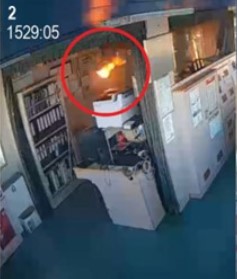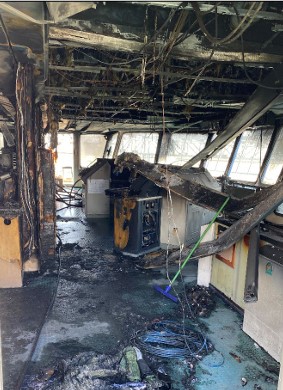 Fire breaks out on the bridge of the tanker. Photo from National Transportation Safety Board press release (Source Stalwart Management Ltd)
Fire breaks out on the bridge of the tanker. Photo from National Transportation Safety Board press release (Source Stalwart Management Ltd)
 Fire damage to the S-Trust tanker bridge. Source of pic US Coast Guard in the official public report.
Fire damage to the S-Trust tanker bridge. Source of pic US Coast Guard in the official public report.
 S-Trust tanker. Photo source US Coast Guard from official public report.
S-Trust tanker. Photo source US Coast Guard from official public report.
A fire sparked by lithium batteries in a handheld radio caused $3m damage to an oil tanker ... and the investigation report has urgent warnings about general lithium battery safety.
The tanker called S-Trust was docked at Baton Rouge in Louisiana in the USA when the radio was left charging on the unmanned bridge.
A fire investigation revealed the blaze was caused by one of the cells in the lithium battery exploding, setting the battery off into what’s known as thermal runaway, a high energy chemical reaction caused when a battery becomes damaged, shorted, overheated, defective or overcharged.
The crew managed to douse the fire but by then the flames, heat and smoke had wrecked the tanker’s high technology navigation, communication and alarm systems.
The fire broke out on November 13, 2022, but the ship had docked two days early to offload almost half-a-million barrels of fuel oil.
According to the official report: “The master of the vessel was working at the desk in his office one deck below the bridge. He had a video monitor next to his desk that showed closed-circuit camera feeds from throughout the vessel, including one from the vessel’s bridge.
“About 1530 the master noted that the camera feed for the bridge was no longer visible so he went up to the bridge to investigate. When he opened the door to the bridge, smoke came out and activated the smoke detector at the top of the stairwell just outside the door.
“The master quickly closed the door, went down to the cargo control room and told the chief mate to stop all cargo operations. After doing so, the chief mate notified the terminal of the fire on the vessel and terminal personnel then contacted the West Baton Rouge Fire Department.”
Once electrics to the bridge had been isolated the crew managed to tackle the intense fire and bring it under control.
An investigation concluded that: ”The cause of this fire was determined to be an energetic event (explosion) involving a lithium ion battery located on the navigation desk.”
The closed-circuit camera on the bridge captured an orange flash immediately followed by a puff of smoke in the area of the communications table where batteries and chargers for hand-held radios assigned to the bridge were located.
Following the flash, smoke and flames were seen growing and expanding as combustible material was consumed by the fire. The investigation concluded that the fire was caused by one of the lithium-ion battery cells on the communications table exploding.
The report concludes that ship crews should never leave batteries charging without anyone present, follow manufacturers’ instructions for the care and maintenance of lithium-ion batteries, properly dispose of damaged batteries and keep batteries and chargers away from heat sources and flammable materials.
Companies should also ensure that lithium-ion batteries and devices that use lithium-ion batteries are certified by Underwriters Laboratory or another recognised organisation.
Lithium battery fires are well-known hazard on board passenger aircraft and it may be the shipping industry needs to look at equipping fleets with AvSax lithium battery fire mitigation bags which are now widely used on aircraft.
AvSax are now on board around 16,750 aircraft operated by more than 100 airline companies worldwide. In short, they are the benchmark for lithium battery fire suppression bags and the best-selling aircraft lithium safety ‘burnbag’ by far.
The reason is that it meets the airline industry recommendation that a lithium battery bag shouldn’t just contain the overheating device, it should continually cool it down too which the AvSax does.
Lithium batteries don’t need oxygen to keep flaring up so cooling them is the most effective way to tackle them. The AvSax is made from military grade material so if the device does explode, the debris will be contained within the bag.
For more on AvSax go to www.avsax.com